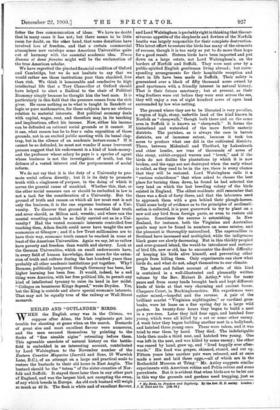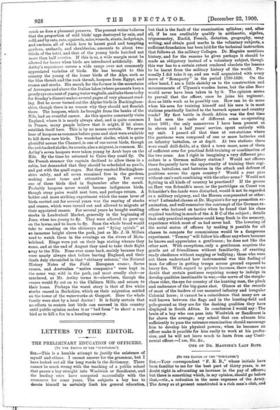EXILED AND " OUTLANDER " BIRDS.
WHEN the English army was in the Crimea, we suppose after Alma, the Irish regiments got into trouble for shooting at game when on the march. Bustards of great size and most excellent flavour were numerous, and the men excused themselves by pointing to the flocks of "fine ateable aigles" retreating before them. This agreeable anecdote of natural history on the battle- field is embedded in an interesting account, contributed by Lord Walsingham to the November number of the Eastern Counties Magazine (Jarrold and Sons, 10 Warwick Lane, E.C.), of an attempt on a large and practical scale to restore the bustards to their old home in East Anglia. The bustard should be the " totem " of the sister-counties of Nor- folk and Suffolk. It stayed there later than in any other part of England, and was the largest bird, not excepting the swan, of any which breeds in Europe. An old cock bustard will weigh as much as 40 lb. The flesh is white and of excellent flavour,
and Lord Walsingham is probably right in thinking that the car- nivorous appetite of the shepherds and fowlers of the Norfolk heaths was largely responsible for their complete destruction. This latest effort to restore the birds has many of the elements of success, though it is too early as yet to do more than hope for a good result. Sixteen birds have been imported and put down on a large estate, not Lord Walsingham's, on the borders of Norfolk and Suffolk. They were sent over by a public-spirited English gentleman living abroad ; but corre- sponding arrangements for their hospitable reception and start in life have been made in Suffolk. Their safety is guaranteed over a block of fifty thousand acres owned by good sportsmen with a friendly interest in natural history. That is their future sanctuary; but at present, as their wing feathers were cut before they were sent across the sea, they will enjoy a run of eight hundred acres of open land surrounded by low wire netting.
The ground where they are to be liberated is very peculiar, a region of high, stony, unfertile land of the kind known in Norfolk as " sheepwalk," though both there and on the same area in Suffolk it is lmown as " sheepwalk." It forms the hinterland and watershed of the more fertile easterly districts. The parishes, as is always the case in barren districts, are of immense extent, because it took ten acres to produce what one did in the cultivated districts. There, between Midenhall and Thetford, by Lakenheath and other heaths, are tens of thousands of acres of this stony, rabbit-cropped warren and " breck," and if the birds do not dislike the plantations by which it is now broken, and the eggs are not destroyed when the early wheat is rolled, as they used to be in the rye. there is every chance that they will be restored. Lord Walsingham calls it a " curious coincidence " that when asked to choose the best place for turning them down, he found he had selected the very land on which the last breeding colony of the birds existed in England. The oldest residents still remember that there was a flock of forty there, and that the labourers used to approach them with a gun behind their plough-horses. Until some body of evidence as to the principles of acclimati- sation is collected, it is pure guesswork to try to plant on a new soil any bird from foreign parts, or even to restore old species. Sometimes the success is astonishing. In New Zealand, for instance, both the Virginian and Australian quails may now be found in numbers on some estates, and the pheasant is thoroughly naturalised. The capercaillies in Scotland have increased and multiplied, while the indigenous black game are slowly decreasing. But in this thickly peopled and over-gunned island, the would-be introducer and restorer of bird life, new or old, has to encounter the double difficulty of keeping his birds alive himself, and preventing other people from killing them. Only experiments can show what birds do, and what do not, adapt themselves to our climate.
The latest and fullest account of efforts of this kind is contained in a well-illustrated and pleasantly written volume by the Rev. Hubert D. Astley,* who for many years and from many lands brought back and kept different kinds of birds at that very charming and ancient house, Chequers Court, in Buckinghamshire. His experiences were rather mixed,—hopeful and the reverse. A pair of the brilliant scarlet " Virginian nightingales," or cardinal gros- beaks, were let loose on a fine spring day in a large wild garden. In twenty-four hours they began to build a nest in a yew-tree. Later they laid four eggs, and hatched four young, which were all killed by a cat or some other enemy. A week later they began building another nest in a hollybush, and hatched three young ones. These were taken, and it was tried to rear them by hand. They died. The indefatigable birds then made a third nest, and hatched two young. One was left in the nest, and was killed by some enemy; the other was reared by hand, grew up, and " lived happily ever after- wards." His food was grapes, skinned, stoned, and cut up. Fifteen years later another pair were released, and at once made a nest and laid three eggs,—all of which are in the Rothschild Museum at Tring:– Mr. Astley suggests similar experiments with American robins and Pekin robins and some parrakeets. But it is evident that when birds are to be let out in this way the grounds and gardens need trapping, just as • My Birds, in Freedom and Captivity. By the Bee. H. D. AJtley. London : J. IL Dent and Co. [12e. ed.]
much as does a pheasant preserve. The present writer believes that the proportion of wild birds' eggs destroyed by rain, and cold, and by cats, rats, squirrels, mice,weasels, stoats, hedgehogs, and cuckoos, all of which love to haunt good and tempting gardens, orchards, and shrubberies, amounts to about two- thirds of the total, and that of the young birds hatched not
more than half survive. If this is so, a wide margin must be allowed for losses when birds are introduced artificially. Mr.
Astley's experience covers a wide range over not commonly appreciated varieties of birds. He has brought to this country the young of the lesser birds of the Alps, such as the blue thrush and the rock thrush, hoopoes from Egypt, and cranes and storks. His search for the former in the mountains of Auvergne and above the Italian lakes (where peasants keep a greedy eye on a nest of young water wagtails, and take them to fry for Sunday's dinner) makes several pages of very pleasant read- ing. But he never turned out the Alpine birds in Buckingham- shire, though there is no reason why they should not flourish there. The hoopoes, which he brought from the banks of the Nile, had an eventful career. As this species constantly visits England, where it is nearly always shot, and is quite common in France, many people believe that it might, if let alone, establish itself here. This is by no means certain. We never hear of hoopoes as common before guns and shot were available to kill down rare birds. The woodchat shrike, which is quite plentiful across the Channel, is one of our rarest birds, though the red-backed shrike, its cousin, also a migrant, is common. Mr.
Astley's seven hoopoes were taken young by Arab boys on the Nile. By the time he returned to Cairo they could fly. On the French steamer the captain declined to allow them in a cabin, but demanded that they should be scheduled as quails, and put with the quail cages. But they reached Buckingham- shire safely, and all seven remained free in the gardens, making most tame and attractive pets. Yet every one of these birds died in September after the moult Probably hoopoes never would become indigenous birds, though stray pairs would nest here, and perhaps return. A bolder and more striking experiment which the same lover of birds carried out for several years was the rearing of storks and cranes, which were turned out and allowed to migrate at'-i their appointed season. For several years he bought nestling storks in Leadenhall Market, generally in the beginning of June, when too young to fly. They were allowed to grow up on the lawns, and to learn to fly. Soon the whole brood would take to roosting on the chimneys and " flying spirals " at an immense height above the park, just as Mr. J. G. Millais used to watch them in the evenings on the rivers of Mata- beleland. Rings were put on their legs stating whence they eame, and at the end of August they used to take their flight away to the Nile. None ever came back, mainly because they were nearly always shot before leaving England, and their death duly chronicled in that " obituary column," the Natural History Notes of the Field. European cranes, Sarns cranes, and Australian "native companies" were kept in the same way, wild in the park, and most cruelly shot—or murdered, as Mr. Astley terms it—elsewhere, though the cranes would fly out on to the Chiltern Hills, and return to their home. Perhaps the worst story is that of five white storks reared in Berkshire, which on their migration settled on the tower of the waterworks at Gosport. Here the whole family were shot by a local doctor! It is fairly certain that no efforts to restore lost birds can succeed in this country until public opinion makes it as "bad form" to shoot a rare bird as to kill a fox in a hunting country.







































 Previous page
Previous page